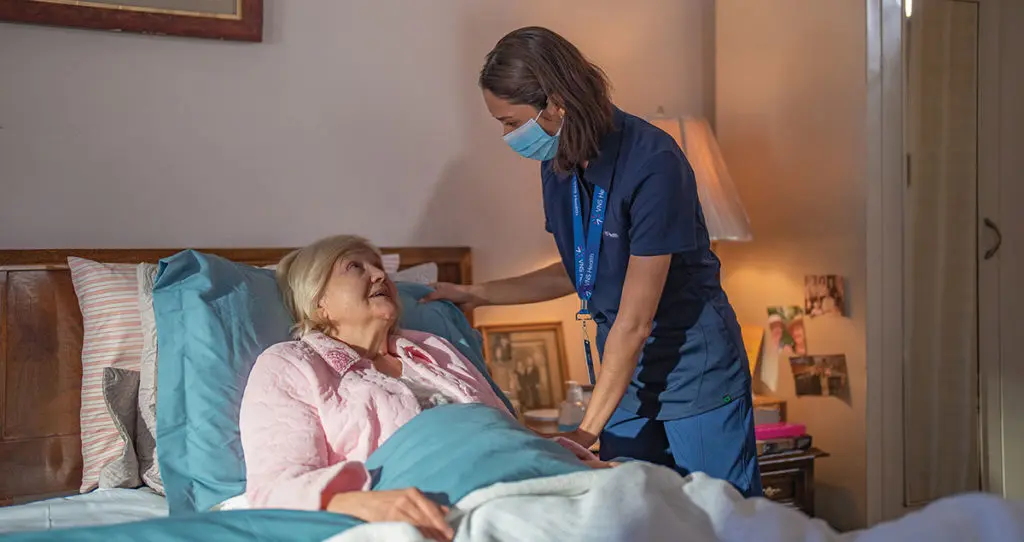
Providers know the qualitative value of hospice care — it is associated with better quality of life, improved pain control, and reduced physical and emotional distress. But can its value be quantified? That question has gone largely unanswered — until now.
In 2022, the National Association for Home Care & Hospice and the National Hospice and Palliative Care Organization commissioned NORC at the University of Chicago to quantify the value of hospice. NORC compared administrative claims data, including length of stay (LOS) in hospice, for 2019 Medicare decedents who did and did not use hospice services in the last year of life.* As described in a 2023 report titled “Value of Hospice in Medicare,” NORC found that a longer stay in hospice is associated with lower Medicare spending, and also with greater patient satisfaction and reduced caregiver stress.
NORC Study Key Findings
- For all disease groups, the break-even point is a LOS of 10 days. End-of-life costs are lower for hospice users who spend 11 days or more than non-hospice users.
- For hospice stays of greater than 6 months, the total cost of care in the year prior to a patient’s death is, on average, 11% lower than the total costs for care for non-hospice users.
- Researchers used a propensity weighting model to adjust the total costs of care for non-hospice users.
- Entering hospice in the last 6 months of life is associated with fewer days spent in, and fewer deaths in, the hospital. (As originally reported in BMJ Supportive & Palliative Care.)
- Family members whose loved one spent more than 30 days in hospice reported the most-positive experiences with end-of-life care. (As originally reported in Journal of Clinical Oncology.)
Levels of Hospice Care
Medicare requires hospice providers to offer four levels of care, depending on the needs of the patient and their caregivers — the goal being to give patients the best quality of care in the place they need it.
- Routine home care. When a patient is stable, a family member or other caregiver works with an interdisciplinary care team to manage symptoms at home. Resources, including 24/7 access to a hospice nurse, are available to avoid the use of emergency care.
- Continuous home care. As an alternative to inpatient care, short-term, temporary skilled care is provided by a nurse (in shifts of 8 to 24 hours a day) to control acute symptoms.
- General inpatient care. When a patient’s symptoms cannot be managed at home, the hospice provider will refer them to a partner inpatient facility for crisis-level care.
- Respite care. To allow caregivers to take some time for themselves, temporary respite care can be provided in a skilled nursing facility.
Hospice care is designed to support terminally ill patients and their caregivers during the last 6 months of the patient’s life, and it’s ideal for an eligible patient to enroll at a stage when symptoms can be readily managed at home. However, patients are often eligible for, and could benefit from, hospice long before they are referred.
Hospice Utilization in New York State
Every year, millions of Americans enter hospice care, and that number continues to increase. In 2020, 1.72 million Medicare beneficiaries received hospice care for at least one day, which was a 6.8% increase from the year before. Because the 1.72 million figure includes only Medicare beneficiaries, the actual number of people who received hospice care was presumably even higher.
Even so, hospice is vastly underutilized, especially in New York. In 2020, New York State had the lowest hospice utilization rate of any state in the country. Only 24.7% of New York Medicare beneficiaries received hospice care, compared to 60.7% in Utah (the state with the highest rate).
With New York’s utilization falling below the national average (46.7%), many New Yorkers are potentially missing out on the benefits of hospice.
Longer Length of Stay in Hospice Adds Value
Hospice stays of any length are beneficial, but longer stays add additional value.
Hospice care increases patients’ quality of life, improves pain control, reduces physical and emotional distress, and — for caregivers and family members — reduces prolonged grief and other emotional distress. Hospice is often what allows people to die at home rather than in a hospital, which is something that 71% of Americans would prefer, but only 31% do.
Despite the increased benefits of starting hospice care as early as possible, nearly half of people who use hospice receive care for less than 15 days.
The NORC report highlights findings from a 2017 study on how families of people with cancer who received hospice care viewed their loved one’s end-of-life care. Families were asked about their loved one’s symptoms, how much pain medication and breathing support they received, the quality of care, and goal attainment. The percentage of positive outcomes, such as loved one received “just the right amount of pain medicine” and end-of-life wishes were followed “a great deal” increased with length of stay in hospice, with families whose loved ones were in hospice for more than 30 days reporting the highest percentage of positive outcomes.
Longer stays also have financial value:
- Medicare budgets are strained by hospitalizations and emergency department utilizations, but these become less likely the longer someone is in hospice.
- Patients avoid costly treatments that offer little benefit.
- Providers in value-based arrangements may be penalized when patients cycle in and out of the hospital. The use of hospice has been advocated to decrease rehospitalizations.
The Importance of Early Referrals
Physicians, nurse practitioners, physician assistants, and other providers can play an active role in ensuring that their patients receive the full benefit that hospice offers by referring their patients to hospice at the right time. It isn’t simply a matter of increasing hospice utilization by referring more patients, but about making referrals earlier in a terminally ill person’s disease trajectory, before they require hospital care to their manage symptoms.
The Palliative Performance Scale can help you objectively determine if it’s time to refer your patient to hospice. The scale assesses a person’s functionality in terms of ambulation, activity and evidence of disease, self-care, food intake, and consciousness level.
At VNS Health, we understand that you may have been caring for your terminally ill patients for months or even years and may be reluctant to talk to your patients about hospice. But the earlier you talk to a patient, the more time they will have to decide if hospice is right for them — and the longer they will be able to enjoy its benefits. We have resources to support you in determining if hospice care is appropriate for your patient and for having difficult conversations with them.
* Medicare covers hospice care for terminally ill patients who have a prognosis of 6 months or less. People who live longer than 6 months, or who choose to leave hospice but then want to reenter, can be recertified.
VNS Health works with providers to ensure that patients and their families are getting everything they can from hospice care. Contact us to learn more about the support that VNS Health can provide or use this form to make a referral.
